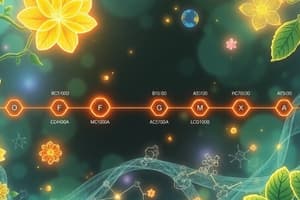Podcast
Questions and Answers
Which of the following organisms employ the shikimate pathway?
Which of the following organisms employ the shikimate pathway?
- Only plants and animals
- All living organisms
- Only microorganisms
- Microorganisms and plants (correct)
What is the origin of the name 'shikimic acid'?
What is the origin of the name 'shikimic acid'?
- From the species of plants it was first isolated from (correct)
- From its role in the synthesis of aromatic amino acids
- From the structure of the molecule itself
- From the Japanese word for 'essential amino acid'
What are the precursors of a wide range of alkaloid structures?
What are the precursors of a wide range of alkaloid structures?
- Only phenylalanine and tyrosine
- Phenylalanine, tyrosine, and tryptophan (correct)
- Cinnamic acids and coumarins
- Only tryptophan
What is the role of phosphoenolpyruvate and D-erythrose 4-phosphate in the shikimate pathway?
What is the role of phosphoenolpyruvate and D-erythrose 4-phosphate in the shikimate pathway?
What is the common feature of cinnamic acids, coumarins, lignans, and flavonoids?
What is the common feature of cinnamic acids, coumarins, lignans, and flavonoids?
What is the source of L-phenylalanine, L-tyrosine, and L-tryptophan for animals?
What is the source of L-phenylalanine, L-tyrosine, and L-tryptophan for animals?
What is the role of shikimic acid in the shikimate pathway?
What is the role of shikimic acid in the shikimate pathway?
What is the relationship between phenylalanine, tyrosine, and tryptophan?
What is the relationship between phenylalanine, tyrosine, and tryptophan?
What is the common feature of the compounds formed from phenylalanine and tyrosine?
What is the common feature of the compounds formed from phenylalanine and tyrosine?
Why are microorganisms and plants capable of synthesizing L-phenylalanine, L-tyrosine, and L-tryptophan?
Why are microorganisms and plants capable of synthesizing L-phenylalanine, L-tyrosine, and L-tryptophan?
Study Notes
The Shikimate Pathway
- Provides three essential amino acids: L-phenylalanine, L-tyrosine, and L-tryptophan
- Employed by microorganisms and plants, but not by animals, making these amino acids essential dietary components
- Central intermediate in the pathway is shikimic acid, which was first isolated from Illicium species (Japanese 'shikimi') plants
- Phosphoenolpyruvate and D-erythrose 4-phosphate combine to form the aromatic amino acids phenylalanine and tyrosine
Aromatic Amino Acids and Derivatives
- Phenylalanine and tyrosine form the basis of C6C3 phenylpropane units, such as:
- Cinnamic acids
- Coumarins
- Lignans
- Flavonoids
- Along with tryptophan, these amino acids are precursors to a wide range of alkaloid structures
The Shikimate Pathway
- Provides three essential amino acids: L-phenylalanine, L-tyrosine, and L-tryptophan
- Employed by microorganisms and plants, but not by animals, making these amino acids essential dietary components
- Central intermediate in the pathway is shikimic acid, which was first isolated from Illicium species (Japanese 'shikimi') plants
- Phosphoenolpyruvate and D-erythrose 4-phosphate combine to form the aromatic amino acids phenylalanine and tyrosine
Aromatic Amino Acids and Derivatives
- Phenylalanine and tyrosine form the basis of C6C3 phenylpropane units, such as:
- Cinnamic acids
- Coumarins
- Lignans
- Flavonoids
- Along with tryptophan, these amino acids are precursors to a wide range of alkaloid structures
Studying That Suits You
Use AI to generate personalized quizzes and flashcards to suit your learning preferences.
Description
This quiz covers the shikimate pathway, which is employed by microorganisms and plants to produce essential amino acids like L-phenylalanine, L-tyrosine, and L-tryptophan. Learn about the role of shikimic acid and other intermediates in this pathway.




